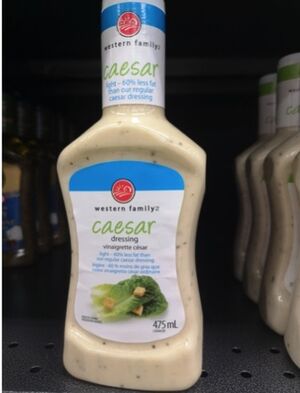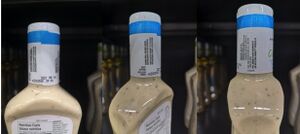Course:FNH200/Assignments/2020/Western family caesar dressing and light caesar dressing


Very briefly introduce your products here[1].
Brand: Western family
Product: caesar dressing and light caesar dressing
Salad dressing
Salad dressing are often mixtures of a variety of ingredients in different phrases. And, they often use additives and substitutes to simplify the production process. Hence making them decent candidates to be studied on for this assignment. We picked caesar dressing and its low-fat peer, light caesar dressing, as typical examples for detailed analysis. We will be listing and performing simple analysis on their ingredients, and compare and contrast the differences of the two products. And, extracting information and meaning from their labels used.
Post pictures (Mandatory)
Include photos of the two products of your choice, clearly showing the ingredient lists and the overall labels - mandatory, if you don't show it, the TA's can't mark the rest.
Instructions on how to add photos and images to UBC Wiki can be found here: https://wiki.ubc.ca/Help:Adding_Media/Images_and_Pictures
Ingredient lists (6 points)
- Type out the lists of ingredients
Brand: Western Family
Caesar Dressing
Ingredient:
- Water

- Soybean oil
- White vinegar
- Parmesan and Romano cheeses
- Frozen egg yolk
- Sugar
- Salt
- Spices
- Modified corn starch
- Garlic
- Concentrated lemon juice
- Phosphoric acid
- Seasoning
- Xanthan gum
- Anchovies

- Potassium sorbate
- Modified milk ingredients
- Dehydrated garlic
- Maltodextrin
- Lactic acid
- Calcium disodium EDTA
- Dehydrated onion
- Flavour
- Citric acid
Light Caesar dressing
Ingredient:
- Water
- Soybean oil
- White vinegar
- Parmesan and Romano cheeses
- Frozen egg yolk

- Sugar

- Salt
- Spices
- Modified corn starch
- Garlic
- Concentrated lemon juice
- Phosphoric acid
- Seasoning
- Xanthan gum
- Anchovies
- Potassium sorbate
- Modified milk ingredient
- Dehydrated garlic
- Maltodextrin
- Lactic acid
- Calcium disodium EDTA
- Glucose
- Dehydrated citrus pulp
- Colour
- Beta-carotene
2. Identify fat substitutes, sugar substitutes, and/or additives used, if there is any
3.Explain the roles of fat substitutes, sugar substitutes, and/or additives used in terms of the functional properties they contribute to the product
Caesar dressing
Fat Substitutes:
- Modified corn starch : used as sensory enhancer
- Modified milk ingredient
- Maltodextrin: used as sensory enhancer to give a creamy feeling
Food additives:
- Phosphoric acid: used for the stable and persistent sour taste
- Xanthan gum: used as emulsifying and stabilizing agent
- Potassium sorbate: food preservative
- Lactic acid: used for sour flavouring and minor preservation agent
- Calcium disodium EDTA: used as chemical stabilizer, flavour preservation agent, and has minor contribution to salty taste
- Citric acid: flavouring agent of sour taste
Light Caesar dressing
Fat Substitutes:
- Modified corn starch: used as sensory enhancer
- Modified milk ingredient
- Maltodextrin: used as sensory enhancer to give a creamy feeling
Food additives:
- Phosphoric acid: used for the stable and persistent sour taste
- Xanthan gum: used as emulsifying and stabilizing agent
- Potassium sorbate: food preservative
- Lactic acid: used for sour flavouring and minor preservation agent
- Calcium disodium EDTA: used as chemical stabilizer, flavour preservation agent, and has minor contribution to salty taste
- Glucose: sweet flavouring agent
4. Compare and contrast the lists of the two products and explain differences
The information on the bottles was almost identical to one another except a few minor details. The most obvious indicator of the difference was the color of the bottles. The regular Caesar dressing had green colour as an indicator while the light Caesar dressing had a blue colour. The light Caesar dressing bottle also had the words light 60% less fat than our regular Caesar dressing written on the front of the bottle. Other differences within the content of the bottle as mentioned on the labels were in the ingredients, food additives, and nutritional facts. For example in the ingredient list,
Caesar: contained Dehydrated onion, Flavour, Citric acid
Light caesar: contained Glucose, Dehydrated citrus pulp, Colour, Beta-carotene
It is obvious that the light caesar dressing has 3g less fat and 20 calories less, despite the similarity appearing in the ingredient list.
Labels (2 points)
- Provide detailed description of the information found on the labels Labels provide the needed information that is required and regulated by Canadian Food Inspection Agency (CFIA). The labels on both bottles were very consistent and provided the needed information according to the guidelines. Naturally since the products were different the labels had some notable differences. The differences for labeling were in the colour of the labels, the nutritional facts, food additives, and ingredients. Due to the nature of the low-fat bottle (colour blue) the amount of fat and calories were lower than the regular bottle (colour green). The low-fat bottle also had a clear written description of its low-fat content written on the bottle. This written description is due to labeling guidelines and a form of advertisement which enhances the appeal of the product. This form of advertisement and labeling offers the same product but with lower fat content and caloric intake, which could be considered more appealing to the consumers. In addition, there was also a different expiry date for each bottle, but this is most likely due to the date it was processed. Aside from the mentioned information about the labels and the content mentioned below, both bottles were the same in every other aspect of labeling and ingredient content. Ingredient differences: Caesar dressing: Dehydrated onion, flavour, citric acid Light Caesar dressing: glucose, dehydrated citrus pulp, colour, beta-carotene Food additive differences: Caesar dressing: Citric acid Light Caesar dressing: Glucose Nutritional facts differences per 15ml: Caesar dressing: ● 50 calories ● Fat 5g (Saturated 1g), (Trans 0.1g), (Polyunsaturated 2.5g), (Omega-6: 2.5g), (Omega-3: 0.3g), (Monounsaturated 1g) ● Sodium 115 mg ● Carbohydrate 1g ● Protein 0.3g Light Caesar dressing: ● 30 calories ● Fat 2g (Saturated 0.4g) ● Sodium 140 mg ● Carbohydrate 3g (Sugars 1g) ● Protein 0.3g
- Indicate whether the information complies with the regulatory requirements as outlined in Lesson 04. The Caesar dressing and light Caesar dressing both had the proper information on the labels of the bottles. The labels followed the guideline from the Canadian Food Inspection Agency (CFIA).They both provided the following: bilingual labelling, common name, country of origin, date markings and storage instructions, name and principal place of business, legibility and location, list of ingredients and allergens, net quantity, nutritional labelling, sweeteners, food additives, and fortification.
| Caesar Dressing | Light Caesar Dressing | |
| Bilingual Labelling
(English, French) |
Yes | Yes |
| Common name | Western Family | Western Family |
| Country of origin | Product of USA | Product of USA |
| Date markings and Storage Instructions | Refrigerate after opening, best before
Mar, 16, 2021 |
Refrigerate after opening, best before Mar,04,2021 |
| Name and principal place of business | Prepared for overwaitea food Groop LP., Box 7200, Vancouver, B.c., V6B 4E4 1-800-242-9229 | Prepared for overwaitea food Groop LP., Box 7200, Vancouver, B.c., V6B 4E4 1-800-242-9229 |
| Irradiated foods | Does Not Apply | Does Not Apply |
| Legibility and location | Yes | Yes |
| List of ingredients and allergens | Yes | Yes |
| Net quantity | Yes | Yes |
| Nutrition labelling | Yes | Yes |
| Sweeteners | Yes | Yes |
| Food additives | Yes | Yes |
| Fortification | Yes | Yes |
| Grades | Does Not Apply | Does Not Apply |
| *Standard of Identity | Qualified | Qualified |
*Mayonnaise Salad Dressing[2]
(a) shall be a combination of
(i) vegetable oil,
(ii) whole egg or egg yolk, in liquid, frozen or dried form, and
(iii) vinegar or lemon juice;
(b) may contain
(i) water,
(ii) salt,
(iii) a sweetening agent,
(iv) spice or other seasoning except turmeric or saffron,
(v) citric, tartaric or lactic acid, and
(vi) a sequestering agent; and
(c) shall contain not less than 65 percent vegetable oil.
Personal Choice (2 points)
Please submit your individual component of this assignment on Canvas to protect your privacy and your personal opinion
References
Please use the Wikipedia reference style. Provide a citation for every sentence, statement, thought, or bit of data not your own, giving the author, year, AND page.
Note: Before writing your wiki article on the UBC Wiki, it may be helpful to review the tips in Wikipedia: Writing better articles.[3]
- ↑ Sample Reference
- ↑ https://laws.justice.gc.ca/eng/regulations/c.r.c.,_c._870/page-40.html. Missing or empty
|title=(help) - ↑ En.wikipedia.org. (2018). Writing better articles. [online] Available at: https://en.wikipedia.org/wiki/Wikipedia:Writing_better_articles [Accessed 18 Jan. 2018].
| This Food Science resource was created by Course:FNH200. |
